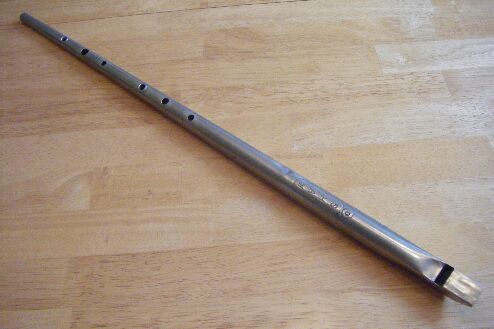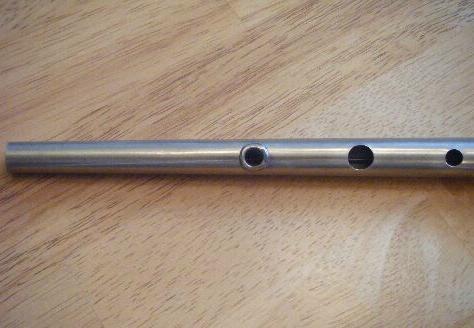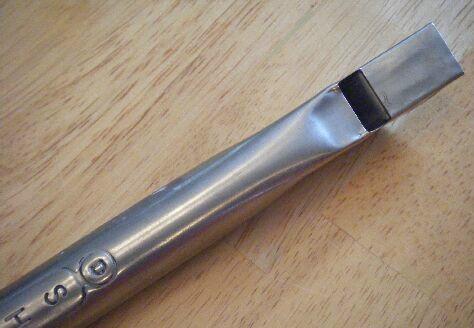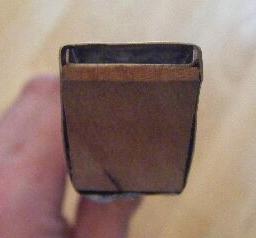Maker - Shaw Whistles (David Shaw) www.daveshaw.co.uk
Material - Nickel Silver sheet with hardwood block.
Dimensions: Length - 22 5/8ths"
Distance between 1st and 3rd bottom holes - 2 6/8ths"
Diameter of 2nd hole from bottom - 3/8ths"
Bore - 3/8ths" (narrow end)
Weight - 4 oz
Price at time of review - 70 lbs direct from Maker
This whistle was lent to me by a kind and generous man for the purposes of review.
I was very glad to have the opportunity, as I never could seem to be
able to bring myself to purchase a Shaw. I wasn't personally overly
fond of it's looks, and the shaw low D had a reputation as a really
breathy whistle. I do want to point out that this is a used whistle
with some damage, including a dent on the top towards the head, and
another dent on the edge of the bottom of the whistle. I am unsure how
this damage may have affected the tuning or tone of the whistle.




Appearance:
Shaws have a distinctive look (albeit similar to a Clarke whistle) that
kinda lends credence to the name "tin" whistle. They are conical in
shape, and are literally made by rolling a sheet of nickel silver into
a cone/tube and then soldering the seam together up the underside of
the whistle. The wide end is then plugged with a piece of hard wood
(held in place by the expedient method of denting the metal into it)
which helps form the fipple. The blade looks like it is created by
cutting a window, then bending the far edge of it down by hand. In fact
the whole whistle gives the impression of being made entirely by hand,
compared to the sleek, lathe turned tubes of most other makes, and sort
of gives the impression that it would be easy to make yourself in your
own basement (which I am most sure it is not!) The bottom and the
fourth finger hole from the bottom both have a metal ring soldered on
to them. I am not sure what the purpose of these rings are, but they
are actually kinda comfortable on the fingers, and I almost wish there
was one on every hole. The narrowness of the conical bore, light
weight, small diameter/size of the finger holes and the comparably
short distance between them make this whistle very easy and comfortable
to play. However, this is somewhat marred by the aforementioned soldered
seam, which creates a bump on the back of the whistle right where you
rest your thumbs. This bump can actually become irritating and even
somewhat painfully with prolonged play. Another feature of the construction
of this whistle I found strange, is that when the body is rolled in on
itself and soldered, one edge of the sheet of metal is actually left
protruding considerably into the inside of the whistle, creating a
long, somewhat large ridge running up the inside (see photo). I just have to think
that this would somehow effect at least the tone if not the tuning of the
whistle. All
in all the Shaw Low D has a quaint, rustic, and some might even say
traditional look to it. A possible bonus for re-enactors? On the flip
side though, it could also be thought to look "cheap" and poorly
constructed.
Tone: As mentioned, I was really nervous about the tone of a Shaw, as I had heard from several sources that they were very breathy. This whistle is in fact, very breathy, but what really surprised me is that I quite like it! I have often equated overly breathy whistles as being "weak" sounding, but this whistle has a warm, strong, resonant tone while still being...very breathy. The low D fundamental note is especially strong and resonant, which is always a favorite whistle feature of mine. The second octave is also warm, resonant as well as being a bit purer then the first, but is definitely not shrill, even into the highest notes.
Volume: Another feature of this Shaw that surprised me was it's volume, as it is quite loud despite it's small, narrow body. I would say it is moderate to loud in comparison to other low D's I have played. However, due to the nature of it's tone, I don't think it would project well in a session environment.
Backpressure/air requirement: I have a few whistle that I felt had little to no backpressure, but I did not know the meaning of absolutely no backpressure until I played this whistle! This whistle has NO backpressure, and consequently has the highest air requirement of any low whistle I have played. I would think anyone trying to play a fast reel on this whistle would be left gasping or even hyperventilating on the floor! On a good note, despite the low backpressure, this whistle does not have issues with notes breaking to easily in either octave at all.
Responsiveness: This whistle is fairly/moderately responsive. However, some ornaments, such as the roll, can get a bit blurred or buried by the breathiness in the first octave, though not so much in the second. Also, possibly due either to its small bore or small finger holes, finger vibrato does not seem to work at all on this whistle.
Clogging: I did not experience any clogging issues with this whistle, most likely due to it's Huge windway.
Tuning: The tuning of this whistle is just all over the place, to the point I almost didn't want to bother going into detail about it, but here goes: The first octave D, F#, B and second octave B were all around 20 cents sharp. The first octave G and E were 30 cents sharp. The first octave A and second octave G and D were ten cents sharp. The C# and second octave E and A were technically in tune from a frequency stand point, however if you looked at the whistle in a "is it in tune with itself" point of view, these notes were flat. That said, unless you have perfect pitch or are playing with other instruments, I wouldn't say it was overly audibly out of tune with itself. No form of cross fingering would produce anything close or even slightly resembling a C natural, so you would have to half hole it on this whistle. Again, I want to point out that this whistle is damaged, and I'm just not sure what effect, if any, these dents would have on the tuning of the whistle.
Sound clip: Einini
Summary: This whistle ended up being quite the mixed bag for me. On the one hand I really liked it's tone, and I did like the feel of the way it played, but on the other hand it had some serious tuning issues, no cross fingered C natural and a horrendous air requirement. And even though I hate to judge a book by it's cover, it really just doesn't look all that professional, well made, or high quality, especially when compared to all the other makes of low whistles out there. So after much struggle and inner turmoil, I'm forced to give this whistle only three holes. I don't think I will ever be willing to pay the cost for a brand new one of these, but I would certainly be open to acquiring a second hand one in better shape, at least for the sake of the tone.

Tone: As mentioned, I was really nervous about the tone of a Shaw, as I had heard from several sources that they were very breathy. This whistle is in fact, very breathy, but what really surprised me is that I quite like it! I have often equated overly breathy whistles as being "weak" sounding, but this whistle has a warm, strong, resonant tone while still being...very breathy. The low D fundamental note is especially strong and resonant, which is always a favorite whistle feature of mine. The second octave is also warm, resonant as well as being a bit purer then the first, but is definitely not shrill, even into the highest notes.
Volume: Another feature of this Shaw that surprised me was it's volume, as it is quite loud despite it's small, narrow body. I would say it is moderate to loud in comparison to other low D's I have played. However, due to the nature of it's tone, I don't think it would project well in a session environment.
Backpressure/air requirement: I have a few whistle that I felt had little to no backpressure, but I did not know the meaning of absolutely no backpressure until I played this whistle! This whistle has NO backpressure, and consequently has the highest air requirement of any low whistle I have played. I would think anyone trying to play a fast reel on this whistle would be left gasping or even hyperventilating on the floor! On a good note, despite the low backpressure, this whistle does not have issues with notes breaking to easily in either octave at all.
Responsiveness: This whistle is fairly/moderately responsive. However, some ornaments, such as the roll, can get a bit blurred or buried by the breathiness in the first octave, though not so much in the second. Also, possibly due either to its small bore or small finger holes, finger vibrato does not seem to work at all on this whistle.
Clogging: I did not experience any clogging issues with this whistle, most likely due to it's Huge windway.
Tuning: The tuning of this whistle is just all over the place, to the point I almost didn't want to bother going into detail about it, but here goes: The first octave D, F#, B and second octave B were all around 20 cents sharp. The first octave G and E were 30 cents sharp. The first octave A and second octave G and D were ten cents sharp. The C# and second octave E and A were technically in tune from a frequency stand point, however if you looked at the whistle in a "is it in tune with itself" point of view, these notes were flat. That said, unless you have perfect pitch or are playing with other instruments, I wouldn't say it was overly audibly out of tune with itself. No form of cross fingering would produce anything close or even slightly resembling a C natural, so you would have to half hole it on this whistle. Again, I want to point out that this whistle is damaged, and I'm just not sure what effect, if any, these dents would have on the tuning of the whistle.
Sound clip: Einini
Summary: This whistle ended up being quite the mixed bag for me. On the one hand I really liked it's tone, and I did like the feel of the way it played, but on the other hand it had some serious tuning issues, no cross fingered C natural and a horrendous air requirement. And even though I hate to judge a book by it's cover, it really just doesn't look all that professional, well made, or high quality, especially when compared to all the other makes of low whistles out there. So after much struggle and inner turmoil, I'm forced to give this whistle only three holes. I don't think I will ever be willing to pay the cost for a brand new one of these, but I would certainly be open to acquiring a second hand one in better shape, at least for the sake of the tone.